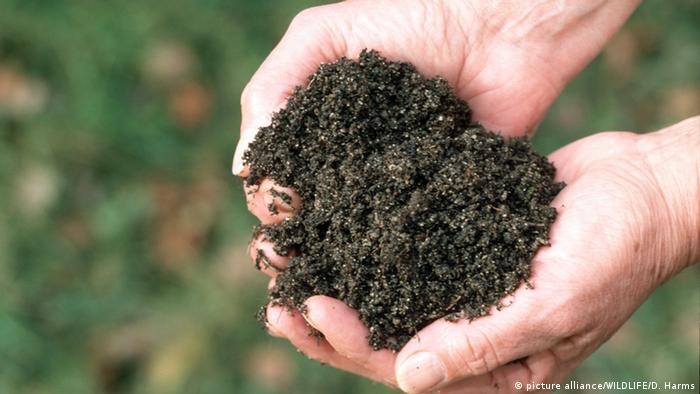To stop further global warming, the burning of fossil fuels must be stopped. In addition, a lot of CO2 has to be removed from the atmosphere, experts say. What options are there for this?

< p>Today the world is on average 1.2 degrees warmer than it was in 1880. By the end of the century it could be 2.7 degrees according to current forecasts.
The main reason for the increase in temperature is the increase in CO2 in the atmosphere. The CO2 is not broken down there, the concentration increases and this slows down the radiation of heat into space – the earth is therefore heating up. The CO2 proportion in the Air has increased from 0.029 to 0.042 percent (288 ppm to 418 ppm) over the last 170 years.
CO2 emissions must be stopped and CO2 removed< /h2>
In order to comply with the Paris climate agreement and to limit global warming to 1.5 degrees if possible, CO2 emissions from the combustion of coal, oil and natural gas must fall very quickly. In addition, according to the Intergovernmental Panel on Climate Change, CO2 must be removed from the atmosphere.
“It's not about either – or,” emphasizes an international research team that has now analyzed the various options for CO2 removal in the first global report “State of Carbon Dioxide Removal (CDR)”.
The authors emphasize that the CDR methods are not a silver bullet against global warming and that CO2 emissions must also be reduced quickly. “But the findings of this report are clear: we also need to increase carbon removal by restoring and enhancing ecosystems and rapidly scaling new carbon removal methods,” says co-author Steve Smith of the University of Oxford. “Many new methods are emerging with potential.”
According to the study, between 450 and 1,100 billion tons of CO2 must be removed from the atmosphere by 2100. The amount depends on how quickly mankind will succeed in reducing CO2 in the coming decades.
The researchers emphasize that it is now a question of boosting the various methods of CO2 removal, and this urgently requires comprehensive political support, which has so far been lacking: “Innovation takes time, upscaling takes time, and if we don't start building these plants now and develop corresponding political plans, we will not make it,” says Jan Minx from the Berlin climate research institute MCC. Few governments have included CO2 storage projects in their national climate plans.
CO2 removal through global reforestation
The next decade will be crucial for the development of strategies and measures for CO2 removal, the researchers emphasize. Currently, the vast majority of CO2 emissions removed from the atmosphere – almost 2 billion tons – is through land use methods reached.
One measure for binding CO2 is the planned reforestation of forests. According to studies, while young trees are growing, around 3.6 billion tons of CO2 could be bound worldwide each year, around 10 percent of current CO2 emissions. Very large areas would be needed for this – in total as much as the area of the entire USA, according to a study by the Swiss Federal Institute of Technology ETH Zurich

Humus with dead plants and soil organisms binds a lot of CO2: humus is lost through industrial agriculture.
Bind CO2 with lots of humus in the soil
Another natural solution is hummus. The dark, rich organic matter in soil is created by the decomposition of plants and animals, so humus is high in carbon.
Due to the industrialization of agriculture, however, a lot of humus has been lost in the soil in recent years. It takes time for new humus to form, but the humus content in the soil can be regained by cultivating catch crops, deep-rooted plants, incorporating harvest residues and avoiding deep plowing increase significantly. According to a study by the Stiftung Wissenschaft und Politik (SWP), a global build-up of humus could bind between two and five billion tons of CO2 per year.
Biochar binds CO2 and makes soil fertile
Some scientists see biochar as a promising technology for binding CO2. In the production of biochar, organic material is charred with the help of heat, pressure and the exclusion of oxygen. In powdered form, this biochar is then spread on farmland. There it acts as a fertilizer, binds water, increases harvests and increases the carbon content in the soil in the long term.
If this technology were used globally, between 0.3 and 6.6 billion tons of CO2 could be bound annually.

Largest CO2 capture facility. Every year it can remove 4,000 tons of CO2 from the air. The CO2 is then bound underground in Iceland forever.
Filter CO2 from the air and store it underground
One method that could bind significantly more CO2 is storing CO2 underground. It is practiced in Norway's oil fields, for example. However, the procedure is also controversial because the CO2 underground can lead to earthquakes and escape in the long term.
Another storage method is practiced in Iceland. CO2 is bound there with basalt and converted to stone. This compound is stable. Some systems (direct air capture) for this already exist in Europe. The potential is great, there is no quantity limit.
The downside is the cost. The Berlin climate research institute MCC assumes costs of between 100 and 300 US dollars per tonne of CO2, depending on the technology used. In contrast, reforestation is financially significantly cheaper at only around 50 US dollars per stored ton of CO2. could drop to 50 euros per ton by 2050.
The technology is considered a key technology for climate protection.
Generate electricity and store CO2 with biomass
Another way of removing CO2 from the air works using biomass. Plants are grown and burned in the power plant to produce electricity. CO2 is then extracted from the exhaust gas of the power plant and stored deep in the earth.
The big problem with this technology (BECCS) is the immense space requirement. For this reason, many experts are critical of this technique. According to Felix Creutzig from the Berlin climate research institute MCC, it will therefore only play “a small role” among the CO2 removal technologies methods, carbonate and silicate rocks are mined, ground and applied to agricultural land or to the sea. Over the years, natural processes bind CO2 to this stone dust and it is stored.
According to research results, the CO2 binding potential with this method is two to four billion tons per year.
< p>The problem with this method is the destructive effects of the mining equipment used to extract the carbonate and silicate rocks.
On January 19th, 2023 the global Report “State of Carbon Dioxide Removal” was published. This article from 2020 has therefore been revised and updated.